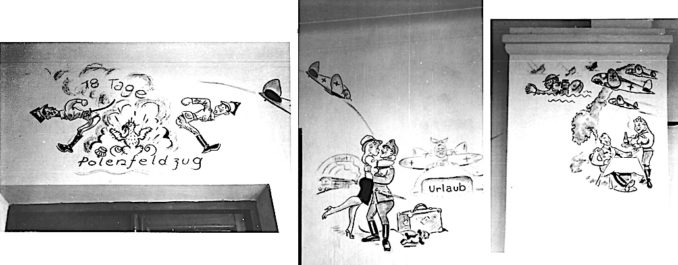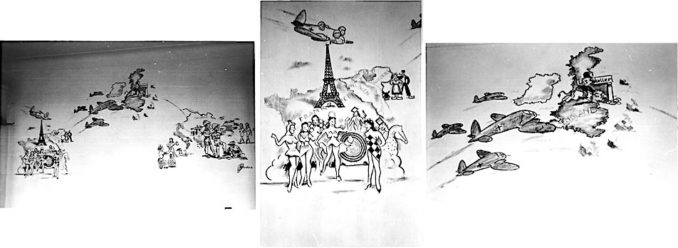Recently, I acquired a set of wartime photographs sourced from a militaria dealer in Munich. The photographs are of cartoons hand-drawn across the whitewashed walls of a room. The style is typical of that seen in WW2, created by soldiers on all sides for their own amusement and that of their comrades.
The difference with these cartoons is that instead of simply being humorous one-offs, they actually form a visual timeline that, through research, could solve the mystery of both where and when they were drawn.
A key repeating element in the cartoons are caricatures of Heinkel He 111 bombers, showing that the artist was an airman in the Luftwaffe. The photographs can be sorted into an approximately panoramic sequence, starting above a door, around a corner, across two pillars, and ending above a shelf of crockery.

© John Tull 2025, Going Postal
The first in the sequence is a cartoon representing the “18 Tage Polenfeldzug” by an explosion between two soldiers wearing the distinctive Polish “Rogatywka” four-pointed military cap, with a Polish eagle between them stripped of its feathers by the blast. This is the 18-day Polish campaign that resulted in Germany and Soviet Russia overrunning Poland and dividing it between them.
The second is of a Luftwaffe officer, complete with ceremonial dagger, embracing a fashionably dressed young woman outside a railway station named “Erfurt”. Alongside this is a caricature of a He 111 pilot in bed with toothache and a sign saying “Urlaub” or leave.
Third is an outline of Norway with sinking ships and a British soldier swimming away pursued by several He 111, whilst a Luftwaffe pilot sitting at a table is being served wine by a blonde-haired young woman wearing a headscarf, skirt and boots.

© John Tull 2025, Going Postal
Fourth in the sequence is a cartoon map of the Netherlands, Belgium and France, with a He 111 overflying the Eiffel Tower, beneath which is a group of scantily clad young women.
The fifth shows a cartoon map of Great Britain, with Churchill riding a lion into a “Bierkeller”, pursued by He 111, and with the Channel filled with sinking ships.

© John Tull 2025, Going Postal
This leads on to the sixth, which is a cartoon map of Italy, Greece, Rhodes and the Balkans, with Luftwaffe airmen in sun helmets and shorts having their boots cleaned and watching two young women in tight dresses walking towards them, whilst another airman by Sicily is being serenaded by a young woman with what could be a bouzouki.
The final cartoons in the sequence are of a He 111 overflying a Middle Eastern mosque with a distinctive dome and arched entry, adjacent to a pilot wearing a sun helmet relaxing in a chair whilst being fanned by a young woman, whilst another kneeling in front of him serves him with refreshment. A comrade is rushing in, shouting the words “Loß, wir fliegen ab” or “Let’s go, we’re taking off!”. At the bottom of the photograph are stacks of crockery and heaps of cutlery on a shelf.
The full set of photographs overlaid give an approximate panorama showing the whole timeline across the room.

© John Tull 2025, Going Postal
So, what can be deduced from this cartoon timeline?
Starting with the only aircraft shown, the cartoons must have been created by an artist in a Luftwaffe Kampfgeschwader or bomber squadron that had taken part in the invasion of Poland before returning to their base for R&R in Erfurt. This squadron then headed to Norway to drive out the British, supported the Blitzkrieg through the Low Countries and in France, before heading to the Mediterranean and Italy, Greece and the Balkans. They finally ended up somewhere in North Africa or the Middle East. So, which squadron did all of this?
To identify where and when the cartoons were drawn, the first step was to identify the Kampfgeschwader (KG) that flew He111 and were active across all of the above countries, undertaking strategic bombing, anti-shipping and ground support, and maritime interdiction. These were KG 1, KG 4 and KG 77. Of these, KG 4 had been formed in 1939 at the airfield of Erfurt-Bindersleben, and only KG 4 had undertaken operations from a base actually in the Middle East.
Researching KG4 then led to finding their involvement in a little-known part of WW2 history, that of the Anglo-Iraqi War in April and May 1941, when Britain declared war on Iraq and invaded its territory after the pro-Axis Iraqi government led by Rashid Ali al-Gaylani sought to align Iraq with Germany and Italy so as to counter British dominance in the Middle East.
The Germans sought to help Rashid Ali al-Gaylani by sending what they named Fliegerführer Irak or Flying Command Iraq, which, as well as Messerschmitt Me109 and Me110 squadrons, included a flight of He111 bombers from KG4.
4./KG4 (4. Staffel or 4th flight of KG4), led by Hauptmann Schwanhäußer, with twelve He111 overpainted with Iraqi markings, were sent to Iraq via Rhodes. They were in Iraq from the 14th to 29th of May 1941, during which time they attacked RAF Habbaniya in Baghdad in support of Iraqi forces and “Kingcol”, a British Army flying column named after Brigadier J.J. Kingstone, that had been sent to relieve RAF Habbaniya and its garrison, which had been under siege since the 30th of April.
Eventually, due to a lack of replacement aircraft, no spares, poor fuel, and aggressive attacks by the British, 4./KG4 were withdrawn, having suffered significant losses, with only two He111 remaining serviceable.
This leads to the probability of these cartoons having been drawn by a member of 4./KG4 on the walls of a Luftwaffe mess around the 21st of May 1941, detailing the history of the squadron from its founding in Erfurt in 1939 through to its brief sojourn in the Middle East. The mosque in the penultimate cartoon probably being the Great Mosque of al-Nuri in Mosul, built in the 12th century and subsequently blown up by ISIS on the 21st of June 2017 during the Iraqi Civil War.
The Luftwaffe mess in Iraq would have been at Mosul airfield, which had originally been RAF Mosul in WW1 before being handed over to the Iraqi Air Force in 1936. After WW2, it was again an RAF airfield before being returned back to the Iraqis in the 1950s. From 2003 to 2007, it was a USAF airbase before reopening as a civil airport, Mosul International. However, between 2014 and 2017, it was destroyed by ISIS but has subsequently been rebuilt and reopened.
After the deployment of 4./KG4, Kampfgeschwader 4 were sent to Russia to support the advance on Leningrad, to fly bombing raids on Moscow, and to support the advance of Heeresgruppe Süd into Ukraine. KG4 then provided cover during the long retreat of the German army from Soviet Russia and Eastern Europe, with the survivors of the squadron surrendering on the 8th of May 1945 to British forces.
Eighty-four years later, possibly the only proof that this artwork existed is the set of photographs now in my collection. The photographer must have returned to Germany for the photographs to have ended up with the militaria dealer in Munich, as the dealer presumably obtained them from a descendant, usually from a house clearance, and potentially without knowing the story behind them.
Did the cartoonist survive Iraq and subsequently the Eastern Front to return to Germany, despite the high level of losses suffered by KG4, and did he draw similar cartoons in other KG4 messes? Those are the so-far unsolved mysteries of the cartoons on a wall.
© John Tull 2025



